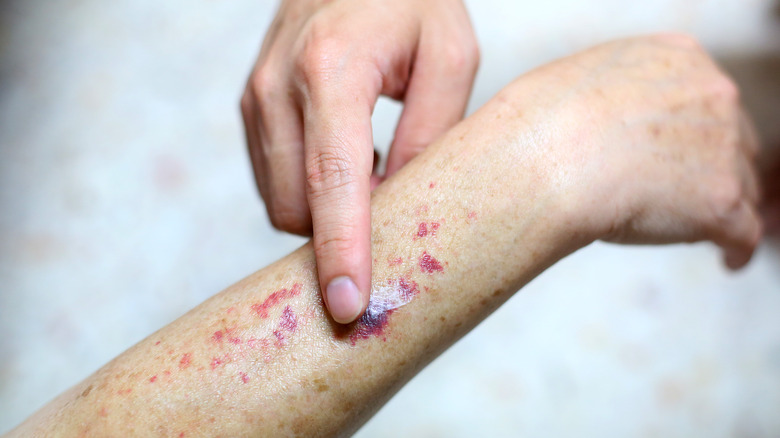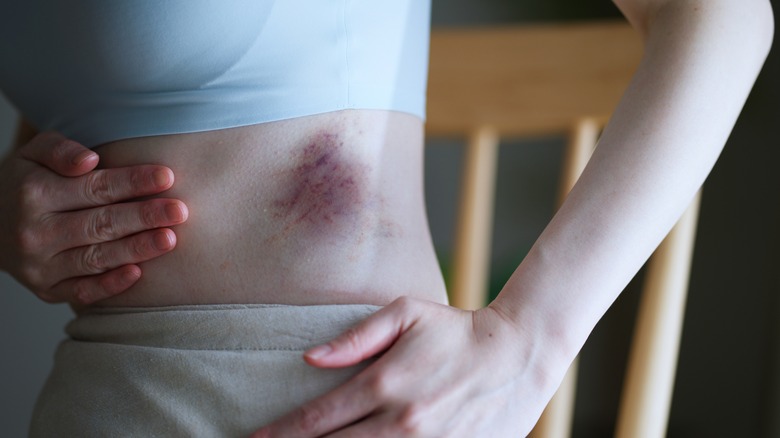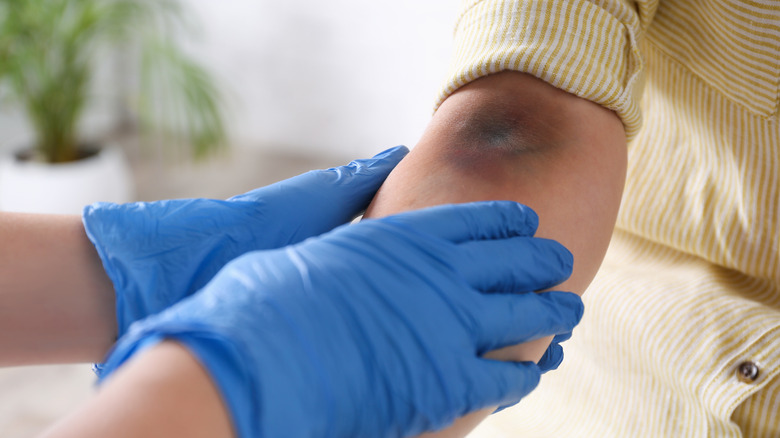Signs Your Body Bruises Are Actually Cancer
You're going about your day only to suddenly notice an unexplained bruise. Did you catch the door on the way out of your room this morning? Did you bump into the dinner table and not notice? Most of the time, you might put down an unexplained bruise to clumsiness, and you might very well be right.
Bruising is often a sign that there's been an injury to blood vessels. Blood escapes the injured vessel and appears as a dark spot under your skin. In fact, the color of the bruise might depend on whether the injured vessels were transporting oxygen to your lungs or taking out carbon dioxide, according to Dr. Eunice Wang, a hematologist and Chief of the Leukemia/Benign Hematology Service at Roswell Park Comprehensive Cancer Center. It would be reddish if it's oxygen and bluish when it's carbon dioxide.
Sometimes, however, a bruise is not to be ignored. Cancers such as leukemias, lymphomas, myeloma, and liver cancer can cause easy bruising. With leukemia, bruising happens because your platelet count is low. Platelets, produced by your bone marrow, perform the all-important job of blood clotting when your blood vessels are injured. When leukemia cells (also originating from your bone marrow) start crowding out healthy cells, including the platelets, you're prone to bruising easily because your body doesn't have enough platelets to do their job of plugging up injured blood vessels. Even though it might be difficult to differentiate normal bruising from leukemia-related bruising, there are a few other warning signs to watch out for.
When is bruising a warning sign of leukemia?
Bruising is quite common with leukemia. The bruises might appear to be a lot darker (almost purple) and their shape could be irregular as well. You may find bruises in areas where you normally wouldn't get a bruise; examples include the head, face, thighs, back, hands, buttocks, ears, and chest. The bruise might seem like it just won't go away or appear to grow bigger. It might also look like the marks are multiplying. Having several bruises appear with no explanation for them is cause for concern.
Sometimes, you may experience conditions like petechiae or purpura. Both are caused, again, by insufficient platelets in your system. Petechiae would look like small red freckles along with small marks. It happens as a result of damage to capillaries (very small blood vessels) and can manifest in places like your arms, legs, stomach, inside your mouth, and even around your eyes. Purpura appears as purplish-red spots under the skin. It is important to note, here, however, that both of these conditions aren't only a result of cancer. They can be caused by infections, vitamin deficiencies, and certain medications too.
If you're constantly having trouble linking a new bruise or multiplying bruises to a valid reason, it's probably best to get yourself checked out. With cancers like leukemia, you'd also be prone to excessive or unusual bleeding and pale skin. Nosebleeds, bleeding gums, and heavy periods are also warning signs. Other symptoms include fevers and chills, unexplained weight loss, excessive sweating, fatigue, bone pain, swollen lymph nodes, and infections.
How is bruising a concern with lymphomas?
Lymphoma, a cancer of the lymphocytes that is generally found in lymph nodes, can be classified into two main types — Hodgkin's lymphoma and non-Hodgkin's lymphoma. There are other varieties too.
Similar to how it happens with leukemia, the spread of lymphoma cells in your bone marrow crowds out healthy blood cells, like platelets, resulting in insufficient platelet levels in your body. As we already know, low platelets mean your blood isn't able to clot the way it's supposed to, resulting in unexplained bruises and unusual bleeding.
Other warning signs of this particular type of cancer include fatigue, swollen lymph nodes in your neck, armpits, or groin area (usually painless), fever, night sweats, itchy skin, and weight loss that you can't explain. With non-Hodgkin's lymphoma, you may also experience bone pain, particularly in the legs, ribs, spine, or pelvis. If you notice, you'll see similarities when it comes to how leukemia and lymphoma manifest.
How is myeloma related to bruising?
Cancer that affects the white blood cells that produce antibodies to protect us from infection — plasma cells — is what's known as "myeloma" or "multiple myeloma."
When your bone marrow produces a great number of myeloma cells, inching out red blood cells, platelets, and other healthy white blood cells, your body, again, is prone to excessive bleeding and bruising.
Myeloma might not cause symptoms in its early stages but that doesn't mean you can't keep an eye out for warning signs. Back, hip, or rib-related bone pain; fractured or weak bones; spinal cord compression; anemia; frequent infections; hypercalcemia (unusually high calcium levels in your body); hyperviscosity (thick blood); and kidney-related issues — which show up as loss of appetite; weight loss; swollen ankles, feet, and hands; fatigue; itchy skin; and shortness of breath — are some other symptoms of this cancer.
How does liver cancer cause bruising?
Both primary and metastatic liver cancer can cause bruising. Primary liver cancer is when the disease forms in the tissues of the liver. With metastatic liver cancer, the cancerous cells originate elsewhere and make their way (through the bloodstream or lymphatic system) to one of the largest organs in your body — the liver.
The bruises associated with liver cancer are slightly different in that they are lumpy, otherwise known as "hematomas." In addition to platelets, your body also needs something called "clotting proteins" (produced in your liver) to prevent injured blood vessels from leaking. When your liver is impaired with primary or metastatic liver cancer, there are insufficient levels of clotting proteins in your body. This is what contributes to excessive or easy bruising and bleeding in this particular type of cancer.
There are other warning signs from your liver that you shouldn't ignore — like unexplained weight loss, loss of appetite, upper right side abdominal pain or right shoulder blade pain, a bloated stomach, feeling full after a meal you otherwise wouldn't consider filling, a hard lump below your ribs, feeling tired, nausea, vomiting, yellowing of the skin (jaundice), itchy skin, pale poop, and dark-hued urine.
When to see a doctor about your bruising
Understanding the warning signs that come with all of these cancers and keeping an eye on your bruises is a good first step. If you're frequently noticing new marks pop up on your skin and you don't know how you got them, it won't hurt to see a doctor for a blood test, especially when there are other symptoms like fevers, excessing bleeding, petechiae, fatigue, night sweats, or swollen glands.
It is important to note that cancer isn't the only cause of unexplained bruising. Being on certain medications like blood thinners, nonsteroidal anti-inflammatory drugs (NSAIDs), steroids, and even some supplements, and health conditions like hemophilia A, hemophilia B (also known as "Christmas disease"), Von Willebrand disease (a genetic mutation-related condition), cirrhosis of the liver, Cushing's syndrome, and vitamin deficiencies can be culprits too.
"The first thing your primary care provider will ask is whether you're on any medication, like a blood thinner or if you take aspirin, and they will probably order a complete blood cell count and possibly additional blood work to look at your bleeding/clotting ratio to see what might be wrong," explained Dr. Eunice Wang of Roswell Park Comprehensive Cancer Center. If there's cause for concern, you will be directed to a hematologist, added the expert. The tests may vary on the kind of cancer. For example, leukemia, multiple myeloma, and lymphoma may require bone marrow biopsies while liver cancer could call for liver tissue analysis.
Now that you know all about how bruises relate to cancer, perhaps you'd like to check out warning signs from your stomach you shouldn't ignore.






